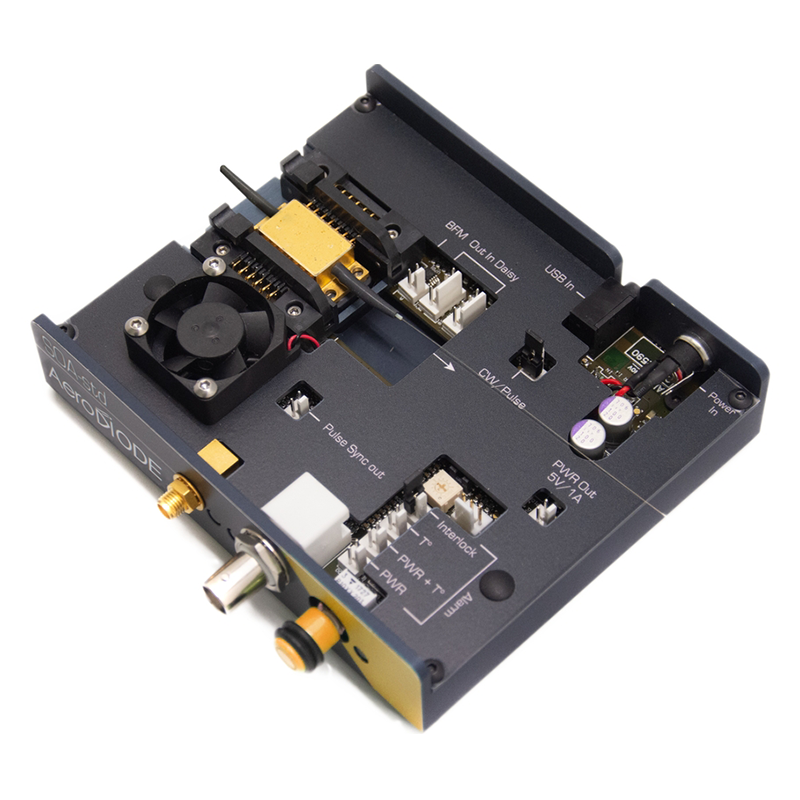Home > Laser Diode Drivers > AeroDIODE > SOA-STD / Control and Mount Module
$3495.00 sku / item#: SOA-STD / Control and Mount Module ships: Request a Quote for Current Ship Date
Key Features
- Pulses from 1 Nanosecond to CW
- Integrated Butterfly Packaged SOA Mount and TEC Controller
- 1.5 Amp Pulsed Current Range
- USB with Control Software GUI Included
- Manufactured by AeroDIODE
Product Warranty
All products purchased from Laser Lab Sourceare sold with a full one-year warranty. See terms & conditions for full details.The Laser Lab Source group websites include:- LaserDiodeSource.com
- LaserLabSource.com
- LaserDiodeControl.com
Price and Delivery Quote
Buy Now / Add to Cart
Customers Also Considered:
| MODEL | SOA-STD / Control and Mount Module |
|---|---|
| PRICE | $3495.00 |
| SOA Pulsed Driver Specifications | |
|
|
| Pulse Generation Mechanism (3 MODES) | |
|
|
| User Interface, Power Input, & Dimensions | |
|
|
Product Overview:
Using an SOA-STD Unit to Create a High Performance Fiber Optic Modulator:
The SOA pulse driver allows the user to employ a semiconductor optical amplifier to create a high speed, high dynamic range fiber optic modulator. It is a high performance alternative to an AOM or an EOM fiber modulator. A CW laser diode is used as the input to the SOA. When the bias current driving the SOA is switched ON/OFF in a pulsed mode (with adjustable speed up to > 1 GHz), the result is a fiber optic modulator which offers multiple advantages over traditional modulator technologies. These units can be configured for wavelengths from 750 nm to 1700 nm. It is a lossless, high extinction ratio and highly polarized modulator solution.
The "SOM" Semiconductor Optical Modulator:
When configured with a CW laser diode input and with and an SOA installed in the pulser, the user creates an "SOM". SOM stands for semiconductor optical modulator. Here are a few of the many advantages an SOM offers relative to an AOM, EOM or directly pulsed laser diode solution:
Type-1 Standard SOA Pin Configuration:
The SOA-STD can be ordered for any butterfly package pin configuration. Because most SOA devices are offered in Type-1 packages, SOA-STD is pre-configured for this package type. Impedance matching is a critical factor in delivering clean high speed pulse performance. This is why the SOA-STD unit is pre-set for your SOA's pin configuration. Please refer to the image carousel above to view available pin settings.
Pre-Set Impedance Matching Improves your SOA's Pulse Mode Performance:
When the impedance from the pulsed current source PCB is not properly matched to the SOA butterfly package pins, significant pulse degradation can occur. This is often seen as distortion of the SOA output pulses and/or overshoot of the pulses. The SOA-STD unit is designed to reduce and/or eliminate this pulse degradation by matching the nominal impedance of the butterfly package with the pulse transmission line. Current sources inherently have a high output impedance and SOA's have very low impedance. The most important requirement of proper impedance matching is matching the impedance of the load to the impedance of the transmission line. The inductance of a butterfly packaged SOA ranges from a few nanohenries to tens of nanohenries. From inductance theory, 𝑑𝑖/𝑑𝑡 is the rate of change in current over a specific period in amperes per second. The voltage increases with the inductance and with the rate of the change of the current. Energy stored in the inductor's magnetic fields during the pulse has to be released when the pulse ends. This creates a voltage, which in turn creates a new current, which in turn creates a new magnetic field on the transmission path. This creates a “loop” which manifests as “ringing” on the pulse waveform and on other distortions to the pulse shape. The SOA-STD current output transmission path has been carefully designed to match the current source impedance to the butterfly packaged SOA.
Why do Scientists & Engineers Choose Laser Lab Source?
-

Get DIRECT, Fast Tech-Support from the Product Engineer, No Sales Person in the Middle
-

Get the Lowest Price, Factory Direct, No Mark-Up's, Suppliers Post their Own Price
-

Get a 30 Day Evaluation Period with No Risk Return on Most Products, Check Availability




